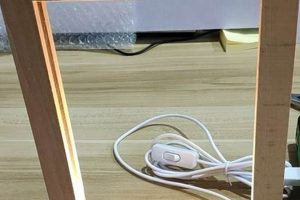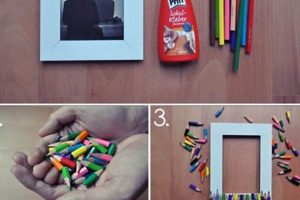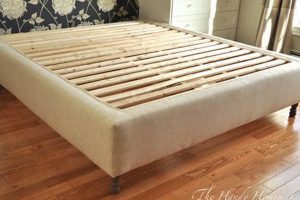A structure created at home to support and display stretched canvas art is a self-assembled framework. This framework provides a rigid border, allowing the artwork to be hung or displayed effectively. For example, an individual might construct a wooden border using basic woodworking tools and materials to encase a painting produced on stretched canvas.
This practice allows for customization regarding size, style, and material, granting the creator greater control over the final presentation of their artwork. Historically, artists often relied on professional framers; however, the accessibility of materials and instructions has facilitated a broader adoption of do-it-yourself approaches. This offers potential cost savings and a more personalized aesthetic.
The subsequent sections will explore materials commonly used, construction techniques applicable to varying skill levels, and considerations for selecting an appropriate style to complement the artwork it will support. Furthermore, methods for ensuring structural integrity and achieving a professional finish will be detailed.
Essential Considerations for Assembling a Supporting Structure for Stretched Canvas Art
The following points offer guidance to ensure a successful outcome when constructing a self-assembled support for canvas artwork. These considerations address material selection, construction techniques, and aesthetic finishing.
Tip 1: Accurate Measurement is Paramount: Precise measurements of the canvas are crucial before commencing construction. Discrepancies can lead to an ill-fitting support structure, compromising the artwork’s presentation and stability. Measure the canvas multiple times and double-check all dimensions.
Tip 2: Select Appropriate Wood: The choice of wood influences the overall structural integrity and appearance. Softwoods, like pine, are more affordable and easier to work with but may lack the rigidity of hardwoods such as oak or maple. Select a wood that balances cost-effectiveness with desired durability.
Tip 3: Utilize Miter Joints for Professional Corners: Mitered corners, cut at a 45-degree angle, create a seamless and aesthetically pleasing appearance. Employ a miter saw or miter box to achieve accurate angles for a tight and professional corner joint.
Tip 4: Secure Joints with Glue and Fasteners: Wood glue provides significant bonding strength. Supplement the glue with fasteners, such as nails or screws, to ensure robust and lasting joints. Consider using corner clamps during the gluing process to maintain alignment.
Tip 5: Ensure Canvas Clearance: When assembling the support structure, allow a slight gap between the canvas and the interior edge of the frame. This prevents the canvas from rubbing against the wood, which can cause damage over time. A small spacer can assist in maintaining consistent clearance.
Tip 6: Consider a Floating Appearance: Create a visually appealing floating effect by constructing a support that is slightly larger than the canvas itself. This reveals a small border of the canvas, enhancing the artwork’s visual impact.
Tip 7: Apply a Protective Finish: After assembly, apply a finish to the wood to protect it from moisture and scratches. Varnish, paint, or stain can be used to complement the artwork and enhance the overall aesthetic.
Adhering to these guidelines can substantially improve the quality and longevity of a self-constructed support structure for canvas artwork. These practices contribute to a visually appealing and structurally sound presentation of the artist’s creation.
The following sections will address specific design choices and advanced construction techniques to further enhance the creation of custom canvas supports.
1. Precise Measurement
Accurate dimensioning forms the foundational element for constructing a self-assembled canvas support. Inaccurate measurements compromise the integrity and aesthetic of the finished piece. Precision is not merely a suggestion; it is a prerequisite for a successful outcome.
- Determining Correct Frame Dimensions
The initial step involves meticulously measuring the canvas. Frame dimensions must correlate precisely with the canvas size to ensure a snug, secure fit without undue stress. An undersized support restricts canvas placement, while an oversized one allows slippage and instability. For instance, if a canvas measures 24 inches by 36 inches, the inner dimensions of the support structure must be precisely 24 inches by 36 inches. Any deviation impacts the final appearance and structural soundness.
- Mitering Accuracy and Corner Alignment
Mitering corners at a 45-degree angle is essential for creating a professional, seamless joint. Inaccurate cuts result in gaps, misalignments, and a visibly flawed appearance. Using a miter saw or miter box provides consistent and accurate cuts. Even a fraction of an inch error per corner accumulates and significantly distorts the overall frame geometry, impacting the squareness and structural integrity. For example, a one-degree error on each corner can compound to a noticeable parallelogram shape in the final assembly.
- Accounting for Canvas Depth
The depth of the canvas necessitates consideration when selecting materials and determining the overall support structure dimensions. Insufficient depth accommodation causes the canvas to protrude excessively, detracting from the aesthetic and potentially exposing it to damage. The frame must be thick enough to accommodate the canvas depth and any mounting hardware. If a canvas is 1.5 inches deep, the support should be constructed with materials that provide at least that much clearance to maintain a flush appearance.
- Measuring for Hanging Hardware Placement
Accurate measurement is crucial when installing hanging hardware. Misplaced hardware results in uneven weight distribution and potential instability. Measurements must be precise to ensure the canvas hangs straight and securely. Marking the correct position for D-rings or wire placement requires meticulous attention to detail. Incorrect placement leads to an unbalanced display, potentially damaging the artwork or the wall upon which it is hung.
Therefore, meticulous attention to dimensional accuracy is paramount when constructing a self-assembled canvas support. This precision extends beyond simple length and width measurements to encompass miter angles, depth accommodation, and hanging hardware placement. Each measurement contributes to the overall structural integrity, aesthetic appeal, and long-term preservation of the canvas artwork.
2. Material Selection
Material selection directly influences the structural integrity, aesthetic appeal, and longevity of a self-assembled canvas support. The choice of material constitutes a foundational decision impacting the entire construction process. Inadequate material selection precipitates structural failure, detracts from the artwork’s presentation, and reduces the support’s lifespan. For instance, the use of low-density fiberboard, instead of solid wood, risks warping under tension from the stretched canvas, potentially damaging the artwork. Similarly, using untreated wood exposes the support to moisture damage and insect infestation, shortening its useful life. The cause-and-effect relationship between material selection and the quality of the finished support is undeniable.
The selection process necessitates considering factors such as wood species, density, moisture content, and potential for warping. Pine offers a cost-effective option, suitable for smaller canvases where strength requirements are less demanding. Oak or maple provides enhanced rigidity and durability, better suited for larger or heavier canvases. The moisture content of the wood affects its stability over time; kiln-dried wood minimizes warping and cracking. Furthermore, selecting materials with appropriate dimensions, such as correctly sized lumber for the frame’s width and thickness, ensures adequate support without adding unnecessary bulk. An example of practical application involves assessing the canvas size and weight, then choosing a corresponding wood type and dimensions to ensure adequate support and prevent sagging.
In summary, material selection represents a critical decision point in the creation of a self-assembled canvas support. The choice dictates not only the structural properties but also the visual presentation and long-term durability. Challenges include balancing cost considerations with desired strength and aesthetic qualities. A comprehensive understanding of material properties and their impact on the finished product is essential for achieving a successful and lasting outcome.
3. Joint Strength
The structural integrity of a self-assembled framework supporting stretched canvas art hinges critically on the strength of its joints. Joint strength, in this context, refers to the ability of the connections between individual components to withstand applied forces without failure. Weak joints undermine the entire structure, leading to instability, deformation, and potential damage to the canvas. The absence of robust joints negates the benefits of otherwise suitable materials and accurate measurements. For instance, if the corners of the supporting framework are weakly joined, the tension exerted by the stretched canvas can cause separation, resulting in a warped or collapsed structure. A clear cause-and-effect relationship exists: insufficient joint strength directly leads to compromised structural performance.
Several factors influence the strength of the joints in a do-it-yourself framework. These include the type of joint employed (e.g., miter, butt, lap), the adhesive used, and the presence and type of mechanical fasteners. Mitered joints, while aesthetically pleasing, require precise execution and strong adhesive bonding to achieve adequate strength. Butt joints, simpler to construct, necessitate reinforcement through additional support or fasteners to compensate for their inherent weakness. Epoxy-based adhesives generally provide superior bonding strength compared to polyvinyl acetate (PVA) glues. Mechanical fasteners, such as screws or nails, offer additional reinforcement, particularly when used in conjunction with adhesive. The combination of appropriate joint type, high-strength adhesive, and strategically placed fasteners represents a best-practice approach to maximizing joint strength. For example, using biscuits or dowels within mitered joints, along with high-quality wood glue and clamping pressure during assembly, significantly increases the connection’s resistance to stress.
Ultimately, understanding and implementing sound joint construction techniques is paramount for creating a durable and aesthetically pleasing self-assembled framework for canvas art. The challenges lie in selecting appropriate materials and methods for the intended application, considering factors such as canvas size, weight, and desired aesthetic. Prioritizing joint strength translates directly to a longer lifespan for the support structure and enhanced protection for the artwork it houses. Neglecting this critical element results in a compromised product, prone to failure and unable to fulfill its intended purpose.
4. Canvas Clearance
Within the context of creating a supporting structure for stretched canvas art, canvas clearance denotes the space maintained between the canvas itself and the inner edges of the framework. This space, while seemingly minor, is a critical factor influencing the long-term preservation and aesthetic presentation of the artwork. Insufficient clearance subjects the canvas to abrasion and potential damage from contact with the rigid support. Conversely, excessive clearance may lead to instability or an aesthetically unappealing floating effect. The construction of a do-it-yourself support necessitates a deliberate consideration of this spatial relationship to ensure optimal results. For example, a frame built without sufficient clearance may rub against the canvas surface, particularly in environments with fluctuating humidity levels, leading to wear and tear on the painted surface over time.
The practical application of clearance considerations manifests in various design choices. When constructing a framework, builders account for the canvas’s thickness and any staples or tacks securing it to the stretcher bars. A slight recess, typically a few millimeters, is incorporated into the framework’s design, preventing direct contact. This recess can be achieved through the use of specialized framing materials or by carefully planning the dimensions of the frame components. Another example is the application of felt or other soft material to the interior edges of the structure, providing an additional buffer. This approach minimizes the risk of abrasion should the canvas shift or vibrate within the frame. Furthermore, the method of securing the canvas within the framework, whether through clips, offsets, or other hardware, influences the required clearance. Each approach necessitates careful measurement and planning to maintain appropriate spacing.
In summary, ensuring adequate canvas clearance is not a mere detail but an integral aspect of constructing a do-it-yourself framework for stretched canvas art. The correct amount of clearance safeguards the artwork from damage, contributes to its stability within the framework, and enhances the overall aesthetic presentation. Neglecting this consideration can result in premature wear, diminished visual appeal, and ultimately, a compromised display. The ability to accurately assess and implement appropriate canvas clearance distinguishes a well-crafted support from a poorly executed one.
5. Aesthetic Finishing
Aesthetic finishing significantly influences the perceived value and presentation of a canvas support structure constructed independently. The application of paints, stains, or varnishes to the wooden framework directly affects its visual integration with the displayed artwork and the surrounding environment. A poorly executed finish detracts from the overall impression, potentially diminishing the artwork’s impact. Conversely, a carefully considered and expertly applied finish elevates the piece, enhancing its visual appeal and contributing to a professional presentation. For instance, a raw, unfinished wooden border around a vibrant, contemporary painting can create a jarring contrast, while a sleek, black lacquered finish may complement the artwork, creating a cohesive visual statement.
Considerations for aesthetic finishing encompass color selection, application technique, and protective qualities. The chosen color should harmonize with the artwork and the intended display location. Application techniques, such as brushing, spraying, or staining, impact the texture and uniformity of the finish. Furthermore, the finish should provide a protective barrier against moisture, scratches, and ultraviolet radiation, preserving the framework’s appearance over time. The selection of a matte varnish versus a gloss varnish, for example, depends on the desired level of reflectivity and the overall aesthetic goal. A real-world application involves sanding the wooden framework to a smooth surface, applying multiple thin coats of paint or stain, and then sealing with a clear coat to achieve a durable and visually appealing finish.
In conclusion, aesthetic finishing is not merely a cosmetic addition but an integral component of a independently created framework. The final finish determines how the support interacts with the artwork, influences its visual impact, and contributes to its long-term preservation. Achieving a successful aesthetic finish requires careful planning, meticulous application, and a thorough understanding of the materials and techniques involved. Challenges include selecting appropriate finishes, mastering application methods, and ensuring compatibility with the artwork and the intended display environment. The time and effort invested in aesthetic finishing are directly proportional to the enhanced value and aesthetic appeal of the finished artwork presentation.
6. Structural Integrity
Structural integrity is a non-negotiable attribute of any self-assembled canvas support. It directly relates to the framework’s capacity to withstand the constant tensile forces exerted by the stretched canvas, environmental factors such as humidity and temperature fluctuations, and physical stresses arising from handling and display. A lack of structural integrity precipitates deformation, instability, and potential failure of the support, resulting in damage to the artwork. For instance, if the framework is constructed from insufficiently robust materials or lacks adequate reinforcement, the canvas tension can cause it to warp or collapse, compromising the artwork’s appearance and structural integrity. The strength and stability of the framework are paramount to ensuring the long-term preservation and optimal presentation of the canvas.
The attainment of structural integrity necessitates careful attention to several key elements. These include the selection of appropriate materials, the implementation of robust joint construction techniques, and the incorporation of reinforcing elements. Hardwoods, such as oak or maple, offer superior strength and resistance to warping compared to softwoods like pine. Mitered joints, while aesthetically pleasing, require precise execution and strong adhesive bonding to withstand tensile forces. Reinforcing elements, such as corner braces or internal crossbars, provide additional support, preventing deformation and enhancing overall stability. An example includes the use of metal corner brackets on a large format canvas support, distributing stress and preventing the corners from pulling apart under the canvas’s tension. The practical application of these principles translates directly into a more durable and reliable framework.
In summary, structural integrity represents a fundamental requirement for a self-assembled canvas support. Its absence jeopardizes the artwork’s preservation and detracts from its aesthetic appeal. By prioritizing the selection of appropriate materials, the implementation of robust joint construction techniques, and the incorporation of reinforcing elements, individuals can ensure the creation of a framework that effectively supports and protects their canvas art for years to come. The challenge lies in balancing cost considerations with the need for long-term durability and stability, requiring informed decision-making throughout the construction process.
7. Customization Options
The capacity for personalized modifications constitutes a core advantage of constructing a framework for supporting stretched canvas art independently. Available choices extend beyond mere dimensional adjustments to encompass material selection, aesthetic presentation, and functional enhancements. This customization directly affects the artwork’s visual impact and its integration into the intended display environment. For instance, an artist might select reclaimed wood to create a rustic frame that complements a landscape painting, or choose a sleek, minimalist design to accentuate a contemporary abstract piece. The ability to tailor the framework to the specific artwork provides a level of control unattainable with pre-fabricated solutions. This inherent flexibility represents a primary driver for individuals who choose to create their own canvas supports.
Customization options further extend to the technical aspects of the support structure. Internal bracing can be modified to accommodate varying canvas sizes and weights, ensuring adequate stability. The type of hanging hardware can be selected based on wall type and desired display aesthetic. Specific finishes, such as UV-resistant coatings, can be applied to protect the wood from environmental damage. For example, a photographer displaying prints in a gallery setting might opt for acid-free mounting materials and UV-protective varnish to ensure the longevity of the exhibited works. These practical modifications enhance the functional performance of the framework and contribute to the long-term preservation of the artwork. The possibilities are considerable and directly linked to the desired outcome.
In summary, the breadth of customization options represents a significant value proposition for creating supports for canvas artwork. This flexibility empowers creators to tailor the framework to their specific artistic vision, ensuring a cohesive and visually impactful presentation. Challenges exist in navigating the vast array of material and design choices, requiring a careful consideration of both aesthetic and structural requirements. However, the ability to personalize every aspect of the framework, from material selection to finishing touches, underscores the inherent appeal and practical benefits of the DIY approach.
Frequently Asked Questions
The following addresses common inquiries regarding the construction and utilization of self-assembled supports for stretched canvas art. These questions and answers provide concise information to assist individuals in making informed decisions.
Question 1: What is the primary advantage of constructing a framework versus purchasing a pre-made one?
The construction allows for customization to specific dimensions and aesthetic preferences. Pre-made options often lack the precision and personalization afforded by a self-assembled framework.
Question 2: What type of wood is recommended for creating a structurally sound support?
Hardwoods, such as oak or maple, provide superior strength and resistance to warping compared to softwoods like pine. The selection depends on the size and weight of the canvas being supported.
Question 3: What is the optimal method for joining the corners of the framework?
Mitered joints, secured with high-quality wood glue and mechanical fasteners, offer a balance of aesthetic appeal and structural integrity. Precise cutting and alignment are essential for a seamless connection.
Question 4: Is it necessary to leave a gap between the canvas and the framework?
Maintaining a slight clearance between the canvas and the framework is recommended to prevent abrasion and potential damage to the artwork. This also allows for slight expansion and contraction of the canvas due to humidity changes.
Question 5: What type of finish is recommended for protecting the wooden framework?
A clear varnish or sealant provides protection against moisture, scratches, and ultraviolet radiation. The choice of finish depends on the desired aesthetic and level of protection required.
Question 6: What tools are essential for constructing a support structure?
Essential tools include a measuring tape, miter saw or miter box, wood glue, clamps, sandpaper, and a finishing applicator (brush or spray gun). Safety glasses and dust masks are also recommended.
In summary, constructing a framework requires careful planning, appropriate material selection, and the application of sound construction techniques. The information provided addresses key considerations for achieving a successful outcome.
The subsequent segments will delve into advanced techniques and explore strategies for troubleshooting common challenges encountered during the construction process.
Canvas DIY Frame
This exposition has detailed the nuanced aspects of creating frameworks for canvas art independently. Key points encompassed material selection, the critical importance of precise measurements, joint strength considerations, achieving proper canvas clearance, aesthetic finishing techniques, ensuring structural integrity, and the vast possibilities for customization. Each element contributes significantly to the quality and longevity of the finished support, ultimately safeguarding and enhancing the presentation of the artwork.
The principles outlined provide a foundation for creating personalized and durable supports. The enduring value of this skill lies in the ability to control the presentation of artistic creations, contributing to their lasting impact and preservation. Further exploration of advanced joinery techniques and material science will undoubtedly refine this craft, yielding even more sophisticated solutions in the future.







